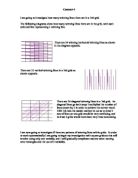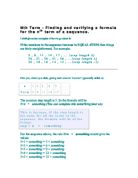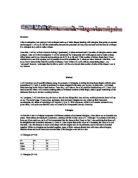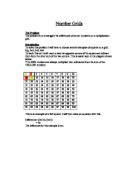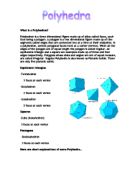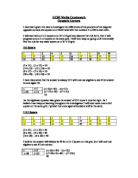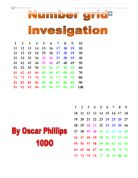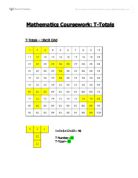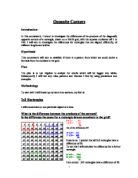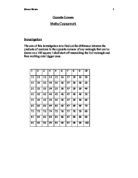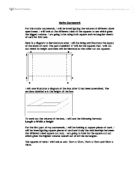investigate how many winning lines there are in a 7x9 grid.
I am going to investigate how many winning lines there are in a 7x9 grid. The following diagrams show how many winning lines there are in the grid, with each coloured line representing 1 winning line. There are 24 winning horizontal winning lines as shown in the diagram opposite. There are 21 vertical winning lines in a 7x6 grid as shown opposite. There are 24 diagonal winning lines in a 7x6 grid. As diagonal lines go both ways I multiplied the number of lines shown by 2 in order to achieve the correct result. I felt this was the easiest method to use as to draw 2 sets of lines on one grid would be very confusing, and to draw 2 grids would have been very time consuming. I am now going to investigate if there are patterns of winning lines within grids. In order to work systematically I am going to begin my investigation with square grids as this will involve using only one variable, and I will gradually complicate matters when moving onto rectangles and the use of 2 variables. Square Grids I am now going to investigate winning lines in square grids. I am going to put my results in a table to enable me to spot any patterns that occur. Winning Lines n (grid size) Horizontal Vertical Diagonal 4 4 4 2 5 0 0 8 6 8 8 8 As we can see horizontal and vertical winning lines are the same in square grids. Horizontal and Vertical Rules The first difference is
Investigation into the effects of levels of processing.
AQA PSYCHOLOGY PROJECT BRIEF PROPOSAL FORM Candidate Name: Noreen Mahmud Centre Name: Allerton High School Centre Number: 37631 Title of work: Levels of Processing PB1: Identify the aim of the research and state the experimental/alternative hypothesis/es. (credited in the report mark scheme) To show how different levels of processing affects the memory. "People who process information deeply (i.e. semantic processing) tend to remember more than those who process information shallowly (i.e. visual processing)." PB2: Explain why a directional or non-directional experimental/alternative hypothesis/es has been selected. (I mark) I have used a directional experimental hypothesis because past research, such as that by Craik and Tulving (1975) has proved this. PB3: Identify the chosen research method (experimental, survey, observation or correlational research) and if appropriate, the design used. (1 mark) I am using a lab experiment as my research method. I am using an independent groups design. PB4: Identify the advantages(s) and disadvantage(s) of the chosen research method. (2 marks) The activity is artificial. However, the findings can be used to help improve the memory. The study is well controlled, so it is unlikely that there are any other factors affecting the findings. However, some participants may guess the aim, and may either try to
Nth Term - Finding and verifying a formula for the nth term of a sequence.
Nth Term - Finding and verifying a formula for the nth term of a sequence. I shall give some examples of how to go about it. If the numbers in the sequence increase in EQUAL STEPS then things are fairly straightforward. For example: 5 , 8 , 11 , 14 , 17 , ... (step length 3) 26 , 31 , 36 , 41 , 46 , ...(step length 5) 20 , 18 , 16 , 14 , 12 , ...(step length -2) First you, draw up a table, giving each term its "counter" (generally called n) n 2 3 4 5 . . . Term 5 8 1 4 7 . . . The common step length is 3. So the formula will be 3×n + something (You can complete this something later on) This is because, if the step length is the same for all the terms in the sequence, the formula will be of the format: step × n + something For the sequence above, the rule 3×n + something would give the values 3×1 + something = 3 + something 3×2 + something = 6 + something 3×3 + something = 9 + something 3×4 + something = 12 + something 3×5 + something = 15 + something You then compare these values with the ones in the actual sequence - it should be obvious that the value of the something is +2 So the formula for the nth term is 3n + 2 That's Easy Enough! A second example.... n 2 3 4 5 . . . Term 26 31 36 41 46 . . . The common step length is 5. So the formula will be 5×n +
GCSE Math Coursework - Shapes Investigation
Summary I this investigation I am going to look at shapes made up of other shapes (starting with triangles, then going on squares and hexagons. I will try to find the relationship between the perimeter (in cm), dots enclosed and the amount of shapes (i.e. triangles etc.) used to make a shape. From this, I will try to find a formula linking P (perimeter), D (dots enclosed) and T (number of triangles used to make a shape). Later on in this investigation T will be substituted for Q (squares) and H (hexagons) used to make a shape. Other letters used in my formulas and equations are X (T, Q or H), and Y (the number of sides a shape has). I have decided not to use S for squares, as it is possible it could be mistaken for 5, when put into a formula. After this, I will try to find a formula that links the number of shapes, P and D that will work with any tessellating shape - my 'universal' formula. I anticipate that for this to work I will have to include that number of sides of the shapes I use in my formula. Method I will first draw out all possible shapes using, for example, 16 triangles, avoiding drawing those shapes with the same properties of T, P and D, as this is pointless (i.e. those arranged in the same way but say, on their side. I will attach these drawings to the front of each section. From this, I will make a list of all possible combinations of P, D and T (or later
T-Totals Maths
T-Totals Coursework My aim is to investigate the relationship between the T-Number and the T-shape on a varying size of grid. 2 3 4 5 To the left is a basic T-shape. In this investigation, the number in bold which is "5" is the T-Number. The sum of the all the numbers in the T-shape is the T-Total. For Example: 1+2+3+4+5 = 10. Therefore the T-Total for this T-Shape is 10. Using this information I can now begin my investgation. 2 3 4 5 6 7 8 9 0 1 2 3 4 5 6 7 8 9 20 21 22 23 24 25 26 27 28 29 30 31 32 33 34 35 36 37 38 39 40 41 42 43 44 45 46 47 48 49 50 51 52 53 54 55 56 57 58 59 60 61 62 63 64 65 66 67 68 69 70 71 72 73 74 75 76 77 78 79 80 81 I am going to start my investiation on a 9 by 9 grid. This shows all the numbers from 1 to 81. Firstly in my investigation, I am going to find a formula that relates my T-Number to my T-Total, firstly with a 9x9 grid and then onto a grid of any size. To work out my formula I have drawn two T-Shapes on my grid. The first t-shape in green has a T-Number of 20. The other T-Shape highlighted in pink has been translated one number to the right giving it a T-Number of 21. I then worked out the T-Total for both shapes. Green T-Shape: 1+2+3+11+20 = 37 Pink T-Shape: 2+3+4+12+21 = 42 T-Number T-Total 20 37 +5 21 42
Number Grids
Number Grids The Problem The problem is to investigate the differences of corner numbers on a multiplication grid. Introduction To solve this problem I will have to choose several examples of squares on a grid: E.g. 2x2, 3x3, 4x4 To work this out I will need to take the opposite corners of the square and subtract them from the other sum of the two corners. This is easier seen in the diagram shown below: *The RED numbers are always multiplied then subtracted from the sum of the YELLOW numbers. 2 3 4 5 6 7 8 9 0 1 2 3 4 5 6 7 8 9 20 21 22 23 24 25 26 27 28 29 30 31 32 33 34 35 36 37 38 39 40 41 42 43 44 45 46 47 48 49 50 51 52 53 54 55 56 57 58 59 60 61 62 63 64 65 66 67 68 69 70 71 72 73 74 75 76 77 78 79 80 81 82 83 84 85 86 87 88 89 90 91 92 93 94 95 96 97 98 99 00 This is an example of a 2x2 square. I will then make an equation with this: Difference= (2x11)-(1x12) = 10 The difference for this example is ten. 2x2 Squares I will use on grid to use several example of 2x2 squares by placing them randomly on the grid. 2 3 4 5 6 7 8 9 0 1 2 3 4 5 6 7 8 9 20 21 22 23 24 25 26 27 28 29 30 31 32 33 34 35 36 37 38 39 40 41 42 43 44 45 46 47 48 49 50 51 52 53 54 55 56 57 58 59 60 61 62 63 64 65 66 67 68 69
New Words
New Words New words are being added to the English language at any different time. New words can be entered for many different reasons. However, it is generally due to the changes in technology and the changes to everyday society. For example, when the technology levels increased do that the computer was developed, the word computer was then invented and added to the English language to fit this change. Throughout this essay I am going to be looking at 8 new words that have been introduced into the English language within the last 50 years. STONED. Entered into the dictionary in 1952. This means to be under the influence of drugs or alcohol. It was first heard in the 1940's where it was used among US jazz musicians. Then it was used to express that someone was under the influence of drink, drugs or euphoria. As is became more commonly used it was used to express that someone was simply under the influence of drink or drugs. As time progressed, the 1960's mainly used it for those under the influence of cannabis. 'Stoned' comes under the form class of an adjective as it is describing the way that a person would be after alcohol or drugs. It is however slang term. "He is stoned". This is one of most common way that the word is used. In this case it means that the male in question has either been drinking alcohol or taking drugs (although in this day and age it
Maths Coursework
Maths Data Handling Coursework: Aim: For this investigation, I am going to select 4 different newspapers, and compare them. I will represent data collection in a number of appropriate forms. I will analyse the content and style of each newspaper and make comparisons between them. I will analyse such things as the content, amount of space devoted to particular items, readability and the size and number of pages. Hypothesis: Different types of newspapers will produce different data and for this reason I selected a range of newspapers. I predict that the broadsheets newspapers will be more detailed; I would expect they will have a greater number of words and the content would be more informative and focused on current affairs. In tabloid newspapers I would expect the content to be less informative and the readability in terms of language to be easier. There would be a visual difference between the types of newspapers in the headlines, fonts and number and type of pictures. Collection Method: I am going to collect a total of four different newspapers: - The Daily Telegraph - The Times - The Sun - The Metro To gather a wide range of results, I will collect 4 different versions of each newspaper. From this data I will be able to compare the newspapers with each other and analyse them. Name of Paper Type of Paper The Daily Telegraph Broadsheet The Sun Tabloid The
Review on short trip to Paris.
Review on short trip to Paris. After an hour and a half flight from Dublin - Beauvais, we took the Coach from Beauvais to the heart of Paris. This cost 20£ return for an hour trip which seemed fair enough, this being part of an agreement with Michael O'Learys, Ryanair to bring his Passengers to Paris from the airport. We arrived at the hotel (High tech montmartre 3***) around 2:00pm and were taken to our rooms via the porter, I'm gonna be very critical of this hotel, as soon as we entered our room the stench out of our toilet was disgusting and it was to remain there for the duration of our stay, I found the staff friendly enough. The selection of breakfast was basic and it probably justified its 3*** rating. The Area, which we stayed in, was very close to Place de Clichy, which is a red light district, I dare not stay out later than 9 o clock in fear of any illegal activity in the area. Place de Clichy was not a rough area but it wasn't a classy place either, nothing like the L'arc de Triomphe, where I found it very clean and friendly looking, but there was always that chance that pick pockets were lurking around. Monday afternoon we took a trip to the Eiffel tower, where I must say that it was well worth the visit. We went to the very top and the views were simply exquisite you could see from miles and miles away, the tower was huge and judging by previous pictures I
Regular Polyhedra
What is a Polyhedron? Polyhedron is a three dimensional figure made up of sides called faces, each face being a polygon. A polygon is a two dimensional figure made up of line segments called edges that are connected two at a time at their endpoints. In a polyhedron, several polygonal faces meet at a corner (vertex). When all the edges of the polygon are of equal length the polygon is called regular. An equilateral triangle and a square are examples made up of three and four edges respectively. Polygons whose sides and angles are not of equal measure, are called irregular. Regular Polyhedra is also known as Platonic Solids. There are only five platonic solids. Equilateral triangles -Tetrahedron 3 faces at each vertex -Octahedron 4 faces at each vertex -Icosahedron 5 faces at each vertex Squares -Cube (hexahedron) 3 faces at each vertex Pentagons - Dodecahedron 3 faces at each vertex Here are short explanations of some Polyhedra... Tetrahedron This is the simplest of all the polyhedra. It uses the least number of faces to enclose any three-dimensional space. The polygon that makes up these faces is also the simplest polygon. Tetrahedron has 4 vertices, 6 edges and 4 faces. Hexahedron Hexahedron is the most common polyhedron. A hexahedron is a polyhedron with six faces. It is often called cube. The thing about the cube (hexahedron) is that all the other


